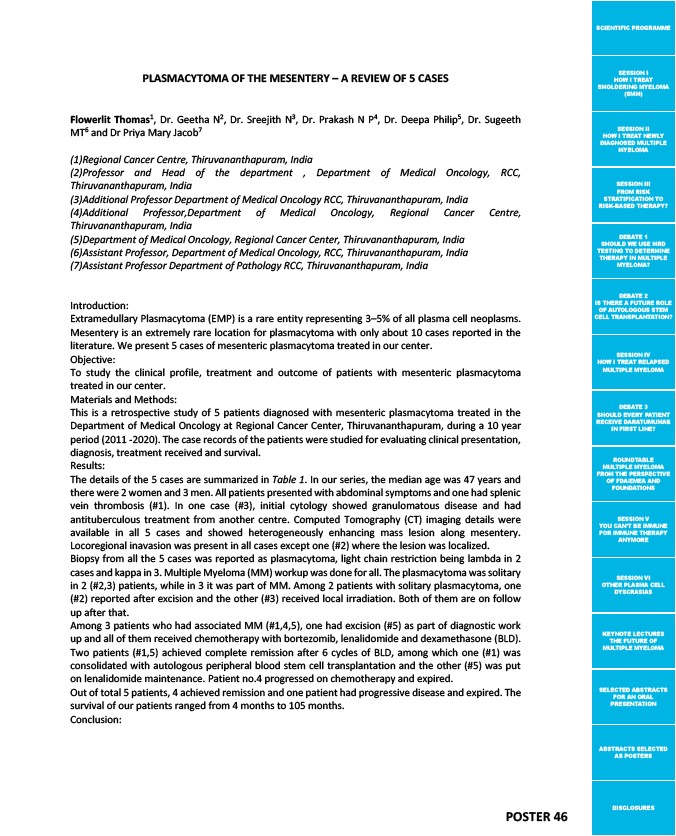
SCIENTIFIC PROGRAMME
SESSION I
HOW I TREAT
SMOLDERING MYELOMA
(SMM)
SESSION II
HOW I TREAT NEWLY
DIAGNOSED MULTIPLE
MYELOMA
SESSION III
FROM RISK
STRATIFICATION TO
RISK-BASED THERAPY?
DEBATE 1
SHOULD WE USE MRD
TESTING TO DETERMINE
THERAPY IN MULTIPLE
MYELOMA?
DEBATE 2
IS THERE A FUTURE ROLE
OF AUTOLOGOUS STEM
CELL TRANSPLANTATION?
SESSION IV
HOW I TREAT RELAPSED
MULTIPLE MYELOMA
DEBATE 3
SHOULD EVERY PATIENT
RECEIVE DARATUMUMAB
IN FIRST LINE?
ROUNDTABLE
MULTIPLE MYELOMA
FROM THE PERSPECTIVE
OF FDA/EMEA AND
FOUNDATIONS
SESSION V
YOU CAN’T BE IMMUNE
FOR IMMUNE THERAPY
ANYMORE
SESSION VI
OTHER PLASMA CELL
DYSCRASIAS
KEYNOTE LECTURES
THE FUTURE OF
MULTIPLE MYELOMA
SELECTED ABSTRACTS
FOR AN ORAL
PRESENTATION
ABSTRACTS SELECTED
AS POSTERS
DISCLOSURES POSTER 46
PLASMACYTOMA OF THE MESENTERY – A REVIEW OF 5 CASES
Flowerlit Thomas1, Dr. Geetha N2, Dr. Sreejith N3, Dr. Prakash N P4, Dr. Deepa Philip5, Dr. Sugeeth
MT6 and Dr Priya Mary Jacob7
(1)Regional Cancer Centre, Thiruvananthapuram, India
(2)Professor and Head of the department , Department of Medical Oncology, RCC,
Thiruvananthapuram, India
(3)Additional Professor Department of Medical Oncology RCC, Thiruvananthapuram, India
(4)Additional Professor,Department of Medical Oncology, Regional Cancer Centre,
Thiruvananthapuram, India
(5)Department of Medical Oncology, Regional Cancer Center, Thiruvananthapuram, India
(6)Assistant Professor, Department of Medical Oncology, RCC, Thiruvananthapuram, India
(7)Assistant Professor Department of Pathology RCC, Thiruvananthapuram, India
Introduction:
Extramedullary Plasmacytoma (EMP) is a rare entity representing 3–5% of all plasma cell neoplasms.
Mesentery is an extremely rare location for plasmacytoma with only about 10 cases reported in the
literature. We present 5 cases of mesenteric plasmacytoma treated in our center.
Objective:
To study the clinical profile, treatment and outcome of patients with mesenteric plasmacytoma
treated in our center.
Materials and Methods:
This is a retrospective study of 5 patients diagnosed with mesenteric plasmacytoma treated in the
Department of Medical Oncology at Regional Cancer Center, Thiruvananthapuram, during a 10 year
period (2011 -2020). The case records of the patients were studied for evaluating clinical presentation,
diagnosis, treatment received and survival.
Results:
The details of the 5 cases are summarized in Table 1. In our series, the median age was 47 years and
there were 2 women and 3 men. All patients presented with abdominal symptoms and one had splenic
vein thrombosis (#1). In one case (#3), initial cytology showed granulomatous disease and had
antituberculous treatment from another centre. Computed Tomography (CT) imaging details were
available in all 5 cases and showed heterogeneously enhancing mass lesion along mesentery.
Locoregional inavasion was present in all cases except one (#2) where the lesion was localized.
Biopsy from all the 5 cases was reported as plasmacytoma, light chain restriction being lambda in 2
cases and kappa in 3. Multiple Myeloma (MM) workup was done for all. The plasmacytoma was solitary
in 2 (#2,3) patients, while in 3 it was part of MM. Among 2 patients with solitary plasmacytoma, one
(#2) reported after excision and the other (#3) received local irradiation. Both of them are on follow
up after that.
Among 3 patients who had associated MM (#1,4,5), one had excision (#5) as part of diagnostic work
up and all of them received chemotherapy with bortezomib, lenalidomide and dexamethasone (BLD).
Two patients (#1,5) achieved complete remission after 6 cycles of BLD, among which one (#1) was
consolidated with autologous peripheral blood stem cell transplantation and the other (#5) was put
on lenalidomide maintenance. Patient no.4 progressed on chemotherapy and expired.
Out of total 5 patients, 4 achieved remission and one patient had progressive disease and expired. The
survival of our patients ranged from 4 months to 105 months.
Conclusion: